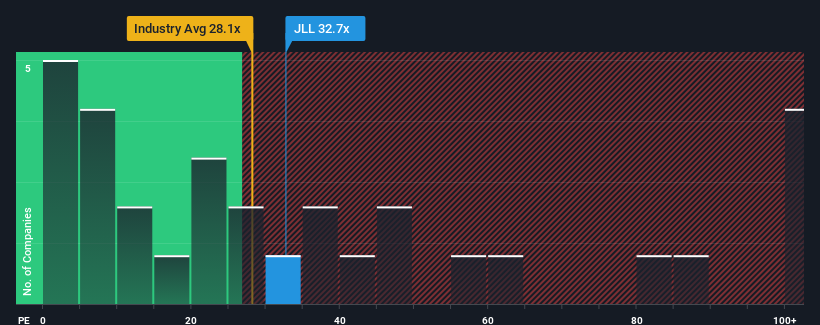- United States
- /
- Real Estate
- /
- NYSE:JLL
Jones Lang LaSalle Incorporated's (NYSE:JLL) P/E Still Appears To Be Reasonable

Jones Lang LaSalle Incorporated's (NYSE:JLL) price-to-earnings (or "P/E") ratio of 32.7x might make it look like a strong sell right now compared to the market in the United States, where around half of the companies have P/E ratios below 16x and even P/E's below 9x are quite common. However, the P/E might be quite high for a reason and it requires further investigation to determine if it's justified.
With earnings that are retreating more than the market's of late, Jones Lang LaSalle has been very sluggish. It might be that many expect the dismal earnings performance to recover substantially, which has kept the P/E from collapsing. You'd really hope so, otherwise you're paying a pretty hefty price for no particular reason.
Check out our latest analysis for Jones Lang LaSalle

Is There Enough Growth For Jones Lang LaSalle?
In order to justify its P/E ratio, Jones Lang LaSalle would need to produce outstanding growth well in excess of the market.
Taking a look back first, the company's earnings per share growth last year wasn't something to get excited about as it posted a disappointing decline of 39%. The last three years don't look nice either as the company has shrunk EPS by 35% in aggregate. Therefore, it's fair to say the earnings growth recently has been undesirable for the company.
Looking ahead now, EPS is anticipated to climb by 42% each year during the coming three years according to the seven analysts following the company. With the market only predicted to deliver 10% each year, the company is positioned for a stronger earnings result.
In light of this, it's understandable that Jones Lang LaSalle's P/E sits above the majority of other companies. It seems most investors are expecting this strong future growth and are willing to pay more for the stock.
The Key Takeaway
While the price-to-earnings ratio shouldn't be the defining factor in whether you buy a stock or not, it's quite a capable barometer of earnings expectations.
We've established that Jones Lang LaSalle maintains its high P/E on the strength of its forecast growth being higher than the wider market, as expected. Right now shareholders are comfortable with the P/E as they are quite confident future earnings aren't under threat. It's hard to see the share price falling strongly in the near future under these circumstances.
Having said that, be aware Jones Lang LaSalle is showing 1 warning sign in our investment analysis, you should know about.
Of course, you might also be able to find a better stock than Jones Lang LaSalle. So you may wish to see this free collection of other companies that have reasonable P/E ratios and have grown earnings strongly.
New: Manage All Your Stock Portfolios in One Place
We've created the ultimate portfolio companion for stock investors, and it's free.
• Connect an unlimited number of Portfolios and see your total in one currency
• Be alerted to new Warning Signs or Risks via email or mobile
• Track the Fair Value of your stocks
Have feedback on this article? Concerned about the content? Get in touch with us directly. Alternatively, email editorial-team (at) simplywallst.com.
This article by Simply Wall St is general in nature. We provide commentary based on historical data and analyst forecasts only using an unbiased methodology and our articles are not intended to be financial advice. It does not constitute a recommendation to buy or sell any stock, and does not take account of your objectives, or your financial situation. We aim to bring you long-term focused analysis driven by fundamental data. Note that our analysis may not factor in the latest price-sensitive company announcements or qualitative material. Simply Wall St has no position in any stocks mentioned.
Have feedback on this article? Concerned about the content? Get in touch with us directly. Alternatively, email editorial-team@simplywallst.com
About NYSE:JLL
Jones Lang LaSalle
Operates as a commercial real estate and investment management company.
Flawless balance sheet and undervalued.
Similar Companies
Market Insights
Community Narratives



